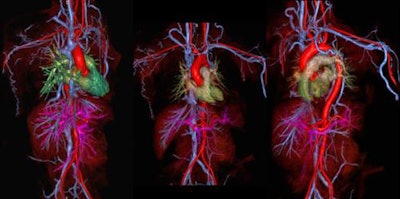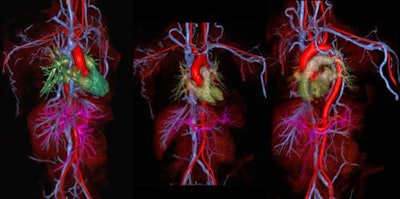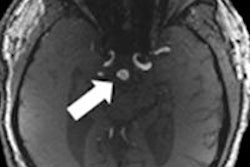
A new, six-minute MR angiography (MRA) procedure to scan blood vessels offers an alternative to claustrophobic patients who can't tolerate a conventional exam, which can take 30 to 60 minutes, according to research presented at the CMR 2018 meeting in Barcelona, Spain.
A team led by Dr Puja Shahrouki of the University of California, Los Angeles (UCLA), developed a shorter test that still produced high-quality images by using ferumoxytol as the contrast agent rather than gadolinium. The benefit of ferumoxytol is it is taken up in the vascular system more quickly than gadolinium-based contrast, which requires patients to wait in the scanner while the clinician watches the contrast move through the body and captures the images when it enters the blood vessels, the researchers said.
The study included seven claustrophobic patients ages 11 to 63 with kidney failure. All patients were hesitant to undergo MRA due to claustrophobia, but agreed to a trial of up to 10 minutes in the scanner bore.
Shahrouki's group conducted eight MRA scans using ferumoxytol, all of which were completed. The scans took an average of 6.27 minutes, and all allowed full visualization of the arterial and venous anatomy from the neck to the thighs.
 Three-dimensional images from MRA with ferumoxytol in a claustrophobic 35-year-old woman with a scanning time of six minutes and 57 seconds. Image courtesy of contributing author Dr. Paul Finn, also of UCLA.
Three-dimensional images from MRA with ferumoxytol in a claustrophobic 35-year-old woman with a scanning time of six minutes and 57 seconds. Image courtesy of contributing author Dr. Paul Finn, also of UCLA."This method could enable claustrophobic patients to receive lifesaving diagnoses and procedures," Shahrouki said in a statement released by the European Society of Cardiology (ESC), which organizes the conference under the auspices of the European Association of Cardiovascular Imaging (EACVI). "It could also shorten waiting lists and improve the cost-benefit ratio for hospitals."



















